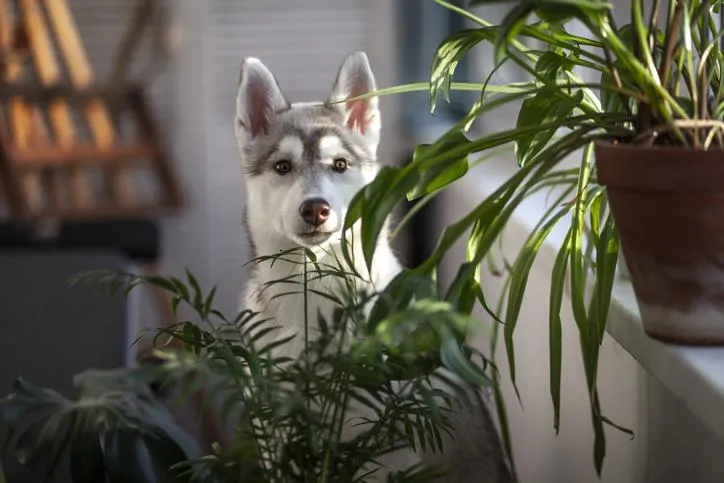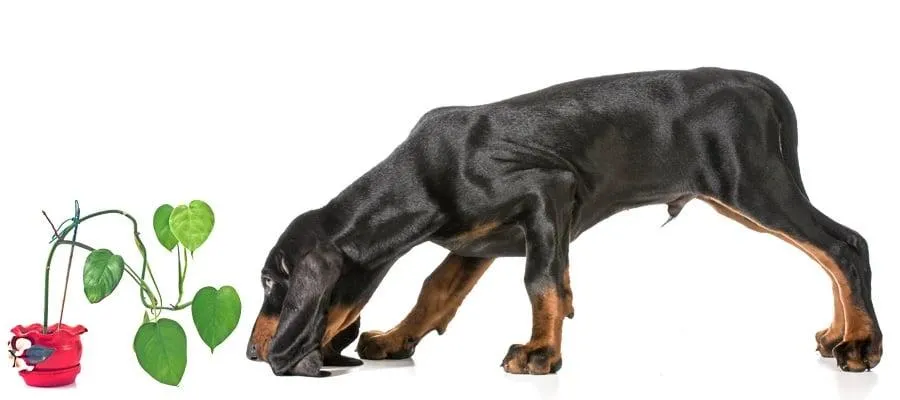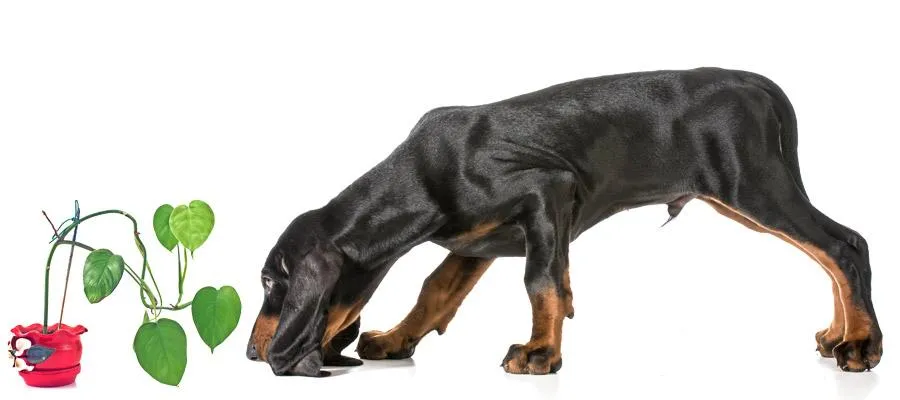Philodendrons: Are They Safe for Dogs?
As plant lovers with pet dogs, many of us want to know if our furry friends can safely coexist with our green friends. One common houseplant people inquire about is the philodendron. In this article, I’ll address all aspects of owning philodendrons and dogs to help you decide if these plants are a good fit for your home.
Philodendron Toxicity
- Most philodendron varieties are mildly toxic to dogs if ingested.
- The main toxin present is calcium oxalate crystals, which can irritate the mouth and digestive tract if eaten.
- Symptoms of philodendron ingestion in dogs may include drooling, vomiting, diarrhea, sore mouth or tongue.
While philodendrons are toxic, their toxicity is considered low compared to other common houseplants. From my experience as a veterinary technician, I’ve rarely seen dogs get more than an upset stomach from nibbling on philodendron leaves. However, there is still a chance of more severe reactions in very small dogs or puppies who eat a large amount.
Dog-Proofing Your Philodendron
The good news is with some precautions, you can absolutely have philodendrons and dogs coexist peacefully in your home. Here are some tips:
- Choose varieties with thicker, waxy leaves that are less appealing to chew, like heartleaf or lemon lime philodendrons.
- Keep plants up high, out of reach on shelves, hanging baskets or mounted on walls.
- Use pet-friendly deterrent sprays on leaves to discourage chewing and licking.
- Supervise any interactions between your dog and philodendron plants.
- Remove any leaves or stems your dog may have access to and ingested immediately.
With close monitoring at first and “dog-proofing” locations, philodendrons can absolutely coexist peacefully with canine companions. As with any new plant introduction, watch your dog closely until you know their preferences.

Philodendron-Friendly Dog Breeds
Certain dog breeds tend to be less interested in plant-munching than others due to their traits and instincts. In general, herding breeds like Collies seem less likely to chew plants compared to hunting hounds bred to use their mouths. From my experience fostering many dogs, here are some breeds that generally leave philodendrons alone when introduced properly:
- Poodle
- Schnauzer
- Greyhound
- Basset Hound
- Bulldog
Of course, every dog has their own personality! But large, calm breeds and smaller “non-chewers” are probably your best bet for a stress-free plant parent-dog dynamic. Getting chew toys can also help redirect any urge to nibble.
Lessons From My Philodendron Experience
I admit, I’ve made a few mistakes in my own attempts to harmony house philodendrons and pets. One time, I totally spaced and left a philodendron on a low coffee table with my elderly pug Oliver. Upon returning, I basically about had a heart attack seeing him gnawing happily away at the plant’s leaves! Thankfully, he seemed fine after his botanical snack. But it was an important lesson to never leave temptation in a pug’s path.
I also overestimated how disinterested my Labradoodle pup would be. While my elderly dogs leave plants alone, the pup was super curious about everything when we first got him. He managed to knock over and destroy a potted philodendron. I kind of had to chuckle at how much trouble that fluffy little guy could get into. But I learned to properly puppy-proof higher up.

The takeaway? Don’t assume anything, especially with younger or more inquisitive dogs. Always supervise and use deterrents until you really know your pet’s behavior. With diligence, philodendrons and most dogs can peacefully co-exist. But best to err on the safe side at first if you value your plants!
Frequently Asked Questions
Q: How do I know if my dog has eaten part of a philodendron?
Monitor your pet closely for symptoms like vomiting, diarrhea or mouth irritation within a few hours of possible ingestion. Philodendron crystals can cause gastrointestinal upset.
Q: Can I use leaf trimmings as dog treats or toys? No, it’s never safe to feed any part of a philodendron plant to dogs due to toxicity risks. Opt for store-bought toys and chews labeled as dog-safe instead.
Q: What do I do if my dog seems sick after eating philodendron? Induce vomiting if possible and contact your vet right away with plant details. They may recommend keeping your dog under observation, giving activated charcoal or fluid therapy depending on symptoms. Don’t delay vet care with a possibly toxic ingestion.

In conclusion, with the right precautions and dog-proofing, many pet parents find philodendrons to be a suitable non-toxic houseplant choice compared to others. As with introducing any new element, watch your pet closely at first until you learn their behavior and preferences. I hope these tips help you decide if welcoming philodendrons into your plant and pet family is the right fit! Let me know if you have any other questions.
Choosing Your Perfect Philodendron or Dog Companion
| Type | Care Level | Size | Lifespan | Family Friendly? |
|---|---|---|---|---|
| Philodendron | Low | Varies by Variety | 10-20 years | Yes |
| Golden Retriever | Medium | Large | 10-12 years | Yes |
| French Bulldog | Medium | Small | 10-12 years | Yes |
| Philodendron Brasil | Low | Medium | 10-15 years | Yes |
| Scottish Terrier | High | Small | 12-14 years | Yes |
| Philodendron Monstera | Low | Large | 10-15 years | Yes |
FAQ
-
Are philodendrons poisonous to dogs?
Philodendrons are toxic if eaten by dogs. The sap can cause mouth irritation and swelling of the throat and tongue if chewed or licked. So it’s best to keep philodendron plants out of reach of dogs.
-
What happens if a dog eats a philodendron?
If a dog eats part of a philodendron, it may experience vomiting, diarrhea, or drooling. The sap contains calcium oxalate crystals which can irritate the mouth and esophagus. Larger amounts could potentially lead to kidney problems. So if you see your dog chewing on a philodendron, you’ll want to induce vomiting right away as a precaution.
-
Can dogs be around philodendrons?
For the most part, dogs can be around philodendron plants if they aren’t chewing on them. The toxicity really depends on the amount ingested. Small bits of foliage the dog may inhale while sniffing are generally not a big deal. However, it’s always better to be safe than sorry. Maybe put the philodendron somewhere higher up or behind a pet gate.

-
Do all types of philodendrons pose the same risk?
Most varieties of philodendrons contain the same type of calcium oxalate crystals that can irritate a dog’s mouth and throat. Nevertheless, some varieties like heartleaf philodendrons and micans may possibly have lower concentrations. But there’s been minimal research, so it’s tough to say for sure which kinds may kinda be safer. Overall, it seems best to consider all philodendrons as potentially poisonous to dogs.
-
What are some non-toxic houseplants suitable for homes with dogs?
Some great low-risk plants to consider include english ivy, bamboo palm, spider plant, pothos, chrysanthemum, peace lily, dracaena, and zz plant. Snake plant and aloe vera are remarkably tough varieties that can even withstand an occasional nibble. Always do your homework though to double check a plant is dog-safe before bringing it home. The ASPCA maintains a helpful list of toxic and non-toxic housplants online.
-
But is keeping houseplants with dogs really worth the risk?
As long as precautions are taken, a few low-risk houseplants can add beauty and atmosphere to a home with dogs. Just be extra vigilant that dogs don’t chew leaves and always have number of the Pet Poison Helpline on hand just in case. Personally, I’d consider rehoming houseplants if a dog was a serious chewer. Overall you need to choose plants wisely based on your dog’s behaviors and preferences. Maybe houseplants are more trouble than they’re worth for some dog owners!
